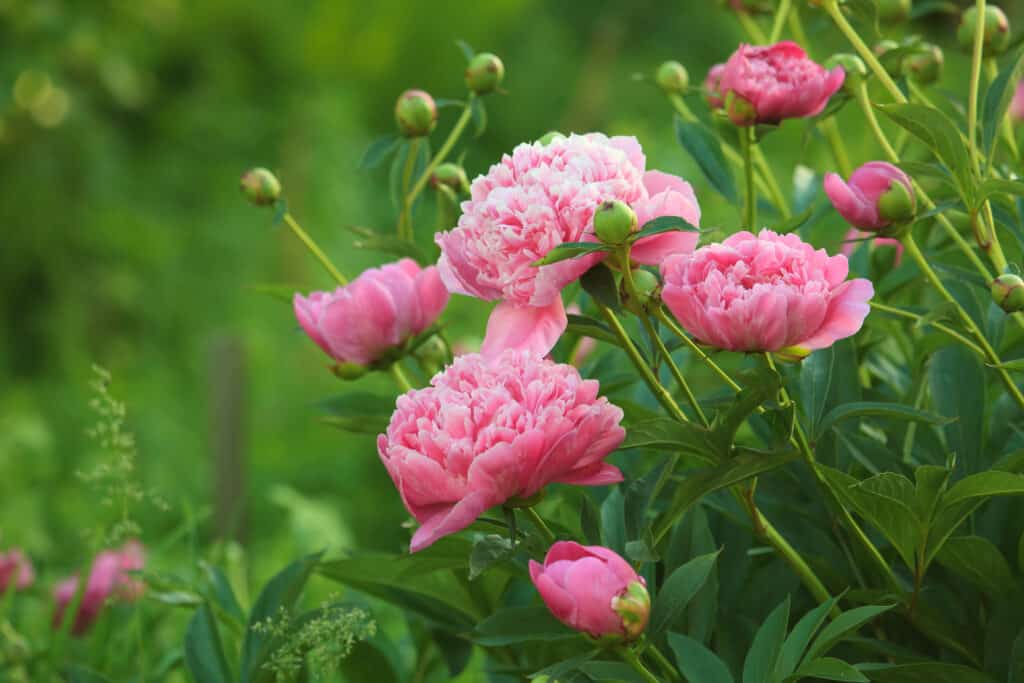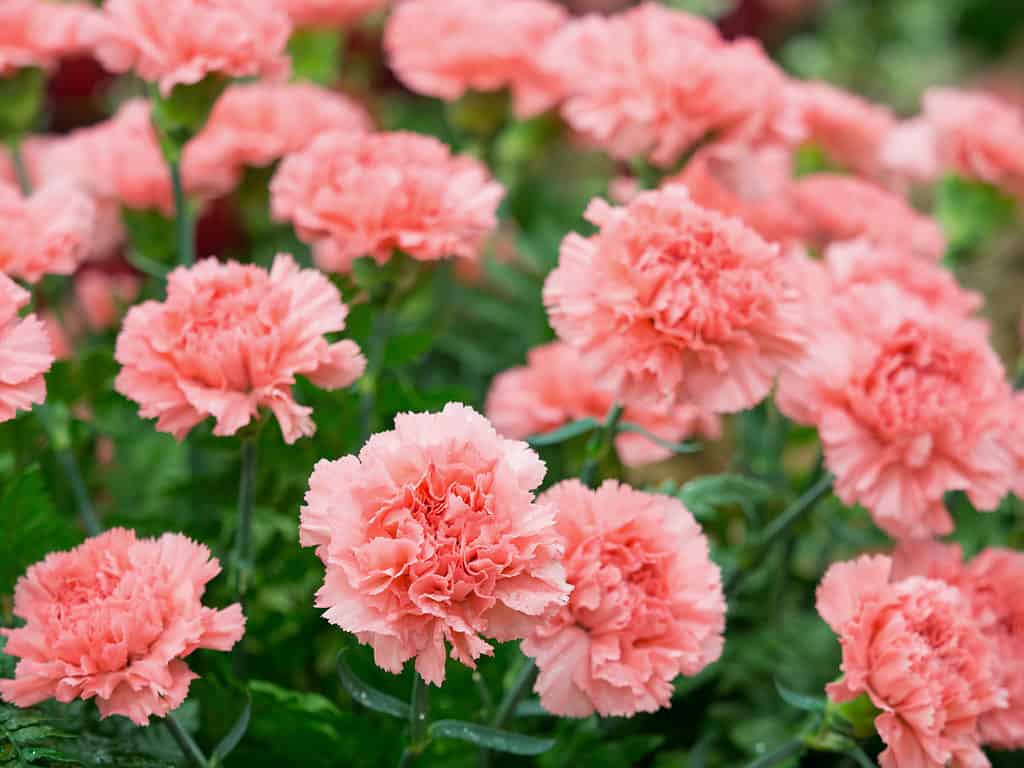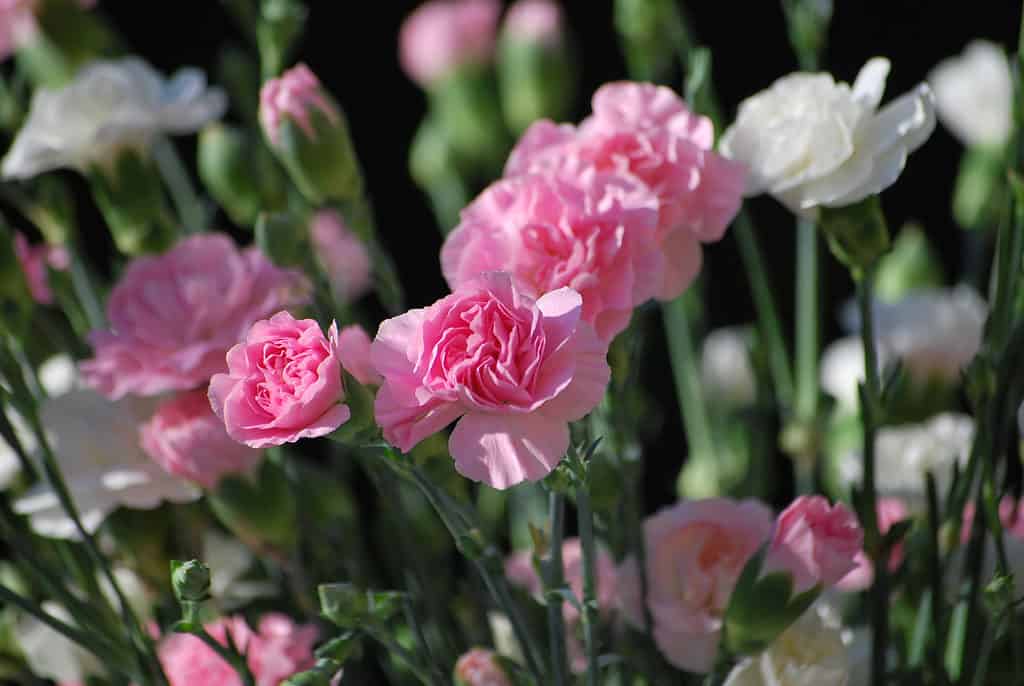Carnations are often considered a cheaper alternative to peonies at the nursery when building bouquets and for a good reason! A fully bloomed carnation has the same ruffly petal texture as a fully bloomed peony. Since both plants bear beautiful flowers, they’re an excellent choice for any bouquet, and since they look similar, you can make bouquets out of both! They’re also beautiful choices for your home garden that can add a splash of fluffy color to your green world.
Peonies vs. Carnations: What’s the Difference?
Peonies and carnations may look similar, but they’re very different plants under the hood. They have different care and propagation needs. So, if you plan to plant these in your garden this spring, you’ll need to keep that in mind. They also have different physical characteristics and histories that you should remember when planting these beautiful flowers.
The primary difference between peonies and carnations is the size and shape of the blooms. Peonies tend to have more prominent blooms than carnations, and peony blooms grow in clusters. Carnation blooms are a tad more solitary. However, because the flowers look similar, they make excellent companions in a garden or a bouquet.

Peonies tend to have more prominent blooms than carnations, and peony blooms grow in clusters.
©iStock.com/Birute
What Is the History of Peonies?
Peonies have a very decorated history and a lot of connections to ancient Greek myths. For starters, the plant is documented as far back as 1000 BCE in the gardens of China. Like most plants cultivated in ancient China, the peony was selected for its medicinal value. The roots and seeds were frequently used to treat asthma and headaches and relieve pain from childbirth.
There is some debate about where the modern name “peony” comes from. Some believe the name comes from the myth of Paeon, a Greek physician who extracted milky sap from the root of the peony and cured Pluto. In doing so, he angered his teacher, Asclepius, who ordered him to be put to death. However, Zeus saved Paeon from execution by turning him into the very flower that caused his call for execution.
Others believe that the name comes from the myth of Paenoia, a nymph who was so beautiful she attracted the attention of Apollo. Out of spite, Aphrodite turned her into a peony. Regardless of where you believe the name came from, this myth is likely the cause of the belief in the middle ages that peonies were bad luck.
Peonies were brought to Europe by explorers in the 1800s.

The peony plant is documented as far back as 1000 BCE in the gardens of China.
©alex172/Shutterstock.com
What is the History of Carnations?
Like peonies, carnations have a decorated history as one of the oldest cultivated flowers in the world. They were commonly used in Greek coronation ceremonies to make ceremonial crowns. The Greek botanist Theophrastus gave the plant its modern scientific name, Dianthus, by combining the Greek words “dios,” meaning Gods, and “Anthus,” meaning flowers.
Another legend that people attribute to the origin of carnations states that the Virgin Mary fell to the ground weeping for her son on his way to Calvary. Where her tears touched, carnations bloomed, leading people to associate these flowers with Godliness.
The herbalist Gerard of Tudor, England, states that peonies mutate very quickly, saying, “How infinite they are… every year every climate and country bringeth forth new sorts.” He also notes that their decorated medical history dates back at least 2000 years from his own knowledge.
Additionally, Shakespeare favored carnations. In Winter’s Tale, a short but heated horticultural debate occurs between Perdita and Polixenes where Polixenes refers to carnations as “nature’s bastards” only to be chastised by Perdita.
Finally, writer and wit Oscar Wilde popularized the green carnation as a symbol of male-male attraction. He instructed his friends to wear green carnations on their lapels to comedy shows. It subsequently caught on as a coded symbol that man was attracted to other men.

Carnations are one of the oldest cultivated flowers in the world.
©yoshi0511/Shutterstock.com
How to Care for Peonies in Your Garden
There are three types of peonies you can plant in your garden. Herbaceous peonies die back to ground level each winter. Tree peonies are taller and woodier and retain their frames throughout the winter. Hybrid peonies have features of both tree and herbaceous peonies, but you may have difficulty finding hybrid seeds. They tend to be rare and harder to find as seeds, but the characteristics of a hybrid peony plant will depend a lot on the individual seeds.
Peonies require moist but well-draining soil and can be planted in early spring or mid-fall. However, the plants will typically flower in May and June, regardless of when you plant them. Additionally, you should cut the plants back in October to help propagate the plants for the next season.
When autumn arrives, you’ll need to propagate next year’s growth by dividing herbaceous peony plants and layering tree peonies.
Peonies require full sun to grow to the fullest extent. So if you’re looking to get those gorgeous, dinner-plate-sized blooms, you’ll need to ensure this plant receives the most sun it can. Unfortunately, peonies don’t tolerate shade as well as sun, but as long as they get at least six hours of full sun, they should be fine with a little bit of shade.

Peonies require moist but well-draining soil and will typically flower in May and June.
©iStock.com/yrabota
How to Care for Carnations in Your Garden
Carnations need to be planted in a location that will get four to six hours of sunlight daily. This is because they prefer sunlight over shade. So consider this when choosing a site to plant your carnation plants. Perennial carnations should be planted from late fall to early spring. In contrast, annual carnations will need to be propagated early and transferred to pots in spring or planted directly into the ground in April or May.
Carnations are a plant that is highly susceptible to overwatering. You’ll want to water your carnations two to three times a week. If the leaves start to turn yellow, you’re giving the plant too much water. So, if you see some yellowing on the leaves, it’s an excellent sign to cut back on how much water you’re giving the plant.
You’ll also want to check to see if you’re getting a tall variety of carnations at the nursery. These varieties require more support and stability than shorter varieties. Tall plants need a support pole or trellis to hold up the stems while growing.

Carnations need four to six hours of sunlight daily and are highly susceptible to overwatering.
©YULIYAPHOTO/Shutterstock.com
Final Thoughts
Peonies and carnations look very similar, making them excellent look-alike plants or companions in a bouquet. They’re also lovely perennials to add to your garden to give it a splash of color with beautiful, eye-catching blooms.
The photo featured at the top of this post is ©
Sources
- Wikipedia, Available here: https://en.wikipedia.org/wiki/Peony
- Wikipedia, Available here: https://en.wikipedia.org/wiki/Dianthus_caryophyllus
- Clemson Cooperative Extension, Available here: https://hgic.clemson.edu/factsheet/peonies/
- Britannica, Available here: https://www.britannica.com/plant/carnation
FAQs (Frequently Asked Questions)
Where do carnations originate?
Carnations originate from the Mediterranean region of Europe and Africa.
Where do peonies originate?
Peonies originate from China in 1000 BCE but get their name from Greek mythology.
Do peonies and carnations have similar growing needs?
Yes, both plants require full sun and well-draining but moist soil to propagate, and they can be propagated by dividing the plants.
Are peonies and carnations the same plant?
No, these are different plants in different plant families.
Thank you for reading! Have some feedback for us? Contact the AZ Animals editorial team.






